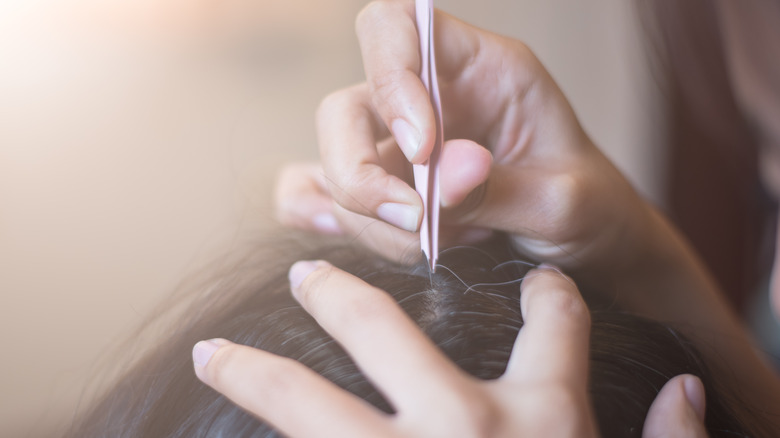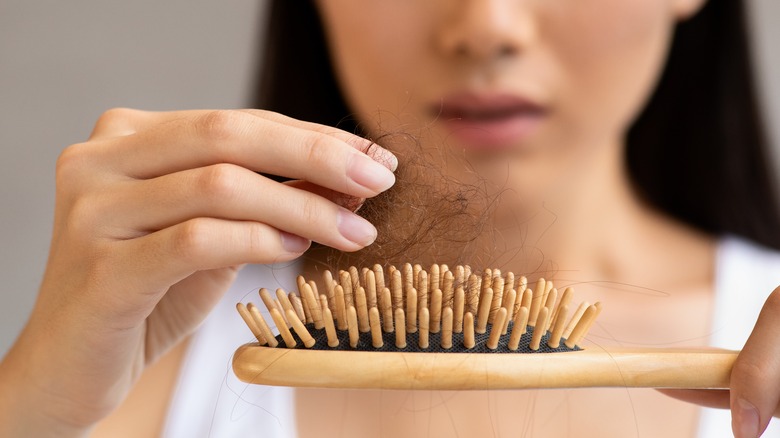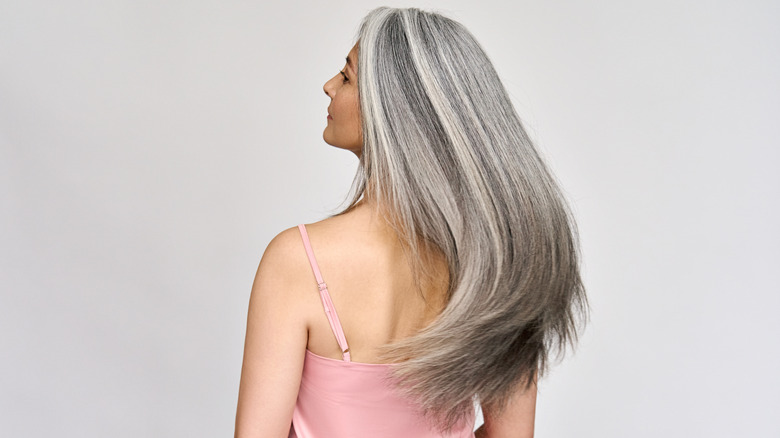The Real Reason You Shouldn't Pull Out Gray Hairs
Growing gray hair is a completely natural part of life. In fact, the pigment in hair gradually decreases with age, usually for people between 28 and 40 years old (via HuffPost). While it is inevitable, some people simply do not enjoy the sight of the grays on their head. It may even be a habitual reaction to want to pluck them out. Because of this tendency, many people believe that when you pull one gray hair out, multiple grays will grow in its place. However, the good news is that this is a myth. But before you head for the tweezers, you should still be careful to avoid plucking your gray hairs out.
Hair grows from a follicle that is a part of your skin on your scalp (per Healthline). If you are thinking about plucking your gray hairs, or already do, consider treating your scalp the same way you would the rest of your skin: with care.
Your hair growth cycle gets affected
More gray hairs cannot grow in the place of the one gray hair you pulled out because only one hair grows per follicle (per HuffPost). According to Healthline, the hair growth cycle occurs in four phases. It begins with the anagen, or growing phase, which is when your hair follicles begin pushing out new hairs and which lasts about three to five years. The next phase, known as the catagen or transition phase, occurs at the end of the anagen phase when the hair follicle shrinks and growth slows down. Next is the telogen or resting phase, when the hair remains in place without growing or falling out. During this phase, the old hair stays in place, or the follicle begins the formation of new hair. Lastly, the exogen or shedding phase occurs at the end of the hair's life cycle. Losing about 50 to 100 hairs per day is actually normal during this phase.
Plucking your gray hair actually expedites this process. Instead of falling out on its own during its shedding phase, you are essentially shortening its life cycle. "The plucked hair whose life you shortened will rest and start its next growth cycle after about three months," hairstylist Michael Van Clarke tells HuffPost. "At each cycle after about age 20, the hair grows back a little thinner and stays around for a slightly shorter time. Cycles on the head average five years, and there are a limited number of growth cycles."
Possible skin damage
Hair begins to gray when the color pigments produced by melanin start decreasing (via SkinKraft). These pigment cells are attached to each individual hair follicle. Once the pigment cells completely die within a follicle, the plucked hair will grow back in white or gray again. Other factors such as genetics or even just life experiences can also affect how quickly you begin to grow gray hairs. Stress is just one example of something that could speed up the process. Therefore, plucking gray hairs will not be as helpful as you may think. You may even cause more damage than good to the health of your hair or scalp.
Many hair experts say that plucking your gray hairs has the potential to cause damage to your hair follicle. "Plucking can traumatize the hair follicle, and you can damage it to the point where it will no longer grow any hair," hairstylist and creative director of education at SACHAJUAN Trey Gillen tells Real Simple. "If you're a serial plucker, repeated 'plucking trauma' can even cause infection, scar formation, and bald patches."
You can avoid this type of damage by simply leaving your gray hairs alone. If their appearance still bothers you, consider dyeing them instead. You can also just cut them off without pulling them out to avoid damaging the hair follicle itself. Or, you can also just embrace your grays, because after all, it's just a natural part of life and gray hairs are beautiful too.


